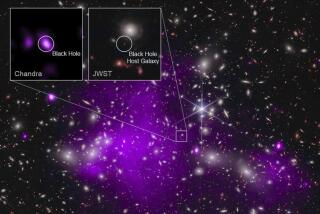Dark energy dates back to young days of universe
- Share via
Dark energy, the enigmatic force that is causing the universe to expand, has been present and constant for at least 9 billion years, a finding that eliminates many of the theories developed to explain its mysterious role in the cosmos, astronomers said Thursday.
The finding provides further support for, but does not prove, Albert Einstein’s idea that a repulsive form of gravity exists in space.
That theory, called the cosmological constant, was developed by Einstein to explain the balance between the expansion of the universe and the powerful gravitational pull of stars and other matter.
He eventually abandoned it, calling it the “biggest blunder” of his career, and the theory lay dormant until the discovery of dark energy in the late 1990s.
The finding that dark energy was present in the early stages of the universe “is a significant clue in the quest to understand what is probably one of the most, if not the most, pressing problems in physics,” said astrophysicist Adam Riess of Johns Hopkins University, who led the team making the announcement.
The research, which will be published in the February issue of Astrophysical Journal, is the latest in a series of discoveries that have “opened up a completely new realm of understanding about how gravity works,” said theoretical astronomer Sean Carroll of Caltech, who was not involved in the research.
Dark energy is analogous to dark matter; scientists have extreme difficulty seeing and measuring them directly, inferring their presence primarily by their effects on visible matter. Dark energy accounts for about 70% of the energy in the universe, scientists believe.
Astronomers now know that in the first 7 billion to 8 billion years after the formation of the universe, its expansion was continually slowed by the gravitational attraction of stars and galaxies.
But beginning 5 billion to 6 billion years ago, the expansion of the universe began to accelerate again, a trend that continues to this day. The invisible force producing this expansion is called dark energy.
There are three views of dark energy, said astrophysicist Mario Livio of the Space Telescope Science Institute in Baltimore.
One is similar to Einstein’s cosmological constant and predicts that dark energy remains constant over time. The second proposes that dark energy is similar to electromagnetic fields and predicts that its strength changes over time. The third holds that we don’t understand gravity and have to change our theories about it.
There has been little evidence to support or refute any of the three.
Riess and his colleagues used the Hubble Space Telescope to discover 23 of the most distant known supernovas, or exploding stars. All date from about 9 billion years ago and their intrinsic brightness is well known.
Astronomers can tell precisely how far away each supernova is by measuring the amount of light that reaches Earth. And researchers can tell how fast each one is moving by measuring changes in wavelength -- the so-called red shift.
In effect, the researchers are able to compute a mass and energy balance for the universe 9 billion years ago, and those computations tell them that dark energy was present then and, within the limits of their accuracy, about as constant as it is today.
“When we subtract the gravity from the known matter in the universe, we can see the dark energy pushing to get out,” said team member Louis-Gregory Strolger of Western Kentucky University.
The ultimate decision on which view of dark energy is correct will require much more data. Riess and his colleagues will continue to search for supernovas with Hubble, but more information could come from the proposed Joint Dark Energy Mission, to be sponsored by NASA and the Department of Energy.
That orbiting observatory would identify as many supernovas in one year as Hubble could in 100.




